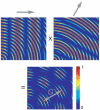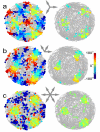Grid cells and theta as oscillatory interference: theory and predictions
- PMID: 19021256
- PMCID: PMC3196519
- DOI: 10.1002/hipo.20518
Grid cells and theta as oscillatory interference: theory and predictions
Abstract
The oscillatory interference model [Burgess et al. (2007) Hippocampus 17:801-802] of grid cell firing is reviewed as an algorithmic level description of path integration and as an implementation level description of grid cells and their inputs. New analyses concern the relationships between the variables in the model and the theta rhythm, running speed, and the intrinsic firing frequencies of grid cells. New simulations concern the implementation of velocity-controlled oscillators (VCOs) with different preferred directions in different neurons. To summarize the model, the distance traveled along a specific direction is encoded by the phase of a VCO relative to a baseline frequency. Each VCO is an intrinsic membrane potential oscillation whose frequency increases from baseline as a result of depolarization by synaptic input from speed modulated head-direction cells. Grid cell firing is driven by the VCOs whose preferred directions match the current direction of motion. VCOs are phase-reset by location-specific input from place cells to prevent accumulation of error. The baseline frequency is identified with the local average of VCO frequencies, while EEG theta frequency is identified with the global average VCO frequency and comprises two components: the frequency at zero speed and a linear response to running speed. Quantitative predictions are given for the inter-relationships between a grid cell's intrinsic firing frequency and grid scale, the two components of theta frequency, and the running speed of the animal. Qualitative predictions are given for the properties of the VCOs, and the relationship between environmental novelty, the two components of theta, grid scale and place cell remapping.
Copyright 2008 Wiley-Liss, Inc.
Figures









References
-
- Alonso A, Klink R. Differential electroresponsiveness of stellate and pyramidal-like cells of medial entorhinal cortex layer II. J.Neurophysiol. 1993;70:128–143. - PubMed
-
- Alonso A, Llinas RR. Subthreshold Na+-dependent theta-like rhythmicity in stellate cells of entorhinal cortex layer II. Nature. 1989;342:175–177. - PubMed
-
- Alyan S, McNaughton BL. Hippocampectomized rats are capable of homing by path integration. Behav.Neurosci. 1999;113:19–31. - PubMed
-
- Barry C, Hayman R, Burgess N, Jeffery KJ. Experience-dependent rescaling of entorhinal grids. Nat.Neurosci. 2007;10:682–684. - PubMed
Publication types
MeSH terms
Grants and funding
LinkOut - more resources
Full Text Sources
Other Literature Sources

